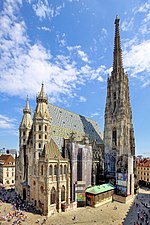Stephansplatz station (Vienna U-Bahn)
1978 establishments in AustriaBuildings and structures in Innere StadtRailway stations in Austria opened in the 20th centuryRailway stations opened in 1978Vienna U-Bahn stations

Stephansplatz is an important destination and interchange station in the Vienna U-Bahn system. It is located under the Stephansplatz and is served by lines U1 and U3. It is located in the Innere Stadt district. Stephansplatz station opened on 18 November 1978. Designated officially as the central node of the U-Bahn by City in on-train announcements and on network maps by a pictogram of its namesake, the Stephansdom, the station serves the heart of the Altstadt and connects two of the busiest lines, making it one of the busiest stations in the city. The U1 between it and Karlsplatz has the highest ridership in the system: approximately 167,000 riders per day in 2004.
Excerpt from the Wikipedia article Stephansplatz station (Vienna U-Bahn) (License: CC BY-SA 3.0, Authors, Images).Stephansplatz station (Vienna U-Bahn)
Stock-im-Eisen-Platz, Vienna Innere Stadt
Geographical coordinates (GPS) Address Nearby Places Show on map
Geographical coordinates (GPS)
| Latitude | Longitude |
|---|---|
| N 48.208055555556 ° | E 16.371666666667 ° |
Address
Stock-im-Eisen-Platz
Stock-im-Eisen-Platz
1010 Vienna, Innere Stadt
Austria
Open on Google Maps









